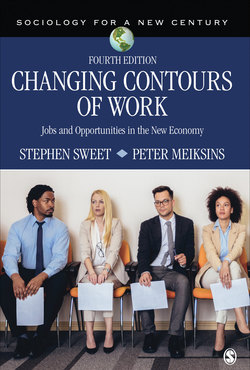Читать книгу Changing Contours of Work - Stephen Sweet - Страница 16
На сайте Литреса книга снята с продажи.
Exhibit 1.6 Mike: A Disadvantaged Youth Enters a Life of Crime
ОглавлениеMike lives on 6th Street in Philadelphia. Aside from its concentrated poverty and predominantly black racial composition, there are two things to note about Mike’s neighborhood: few good jobs are to be found there and police surveillance is pervasive. Because of limited employment options, crime and the illegal work that operates in an underground economy are common. The hyperpolicing that attempts to control Mike and his friends operates with scant tolerance for illegal behavior, focusing on sorting the “dirty” residents from the “clean.” Those who are dirty—like Mike, who engages in the drug trade—face likely imprisonment. Not everyone on 6th Street is dirty. Compared to some other residents, Mike was not as entirely disadvantaged. His mother worked multiple jobs and kept a clean house.
Mike was first arrested at age thirteen for carrying marijuana, but unlike the lenient treatment that he might have received if the same infraction occurred in a middle-class community, he was convicted, given a record, and placed on probation. By the time Mike reached age twenty-two, he had two children with his girlfriend and was selling crack cocaine for extra money to supplement the limited income he earned in a part-time job at a pharmaceutical warehouse. Mike lost his job at the warehouse because he missed too much work while trying to also attend to the needs of his family, including the extra care demanded by his youngest daughter who was born with health problems. When he failed to find a replacement job, he turned to selling drugs as a primary source of income. The rest of his life has unfolded as a story of a life on the run, with incarceration and the prospect of jail time removing him further and further from the hope of ever attaining secure legitimate employment.
Note: Based on On the Run: Fugitive Life in an American City (pp. 14–19) by Alice Goffman, 2014, Chicago: University of Chicago Press.
The six vignettes, all based on real people performing real work, give a sense of the diversity, opportunity, and constraint that exist in the new economy. For Meg and Kavita, economic changes have opened new opportunities, but they coexist with enduring sets of expectations about what mothers and daughters should provide to their spouses, parents, and children. These cultural orientations seem more appropriate to another era and lag behind what these workers ideally want for themselves and, in many instances, what they can provide for others. For Tammy, the moving platform of history has introduced new career tensions because the types of jobs she performed during her entire career have become more difficult to find. And as she tried to find security by investing in the new economy, her meager savings vanished. Emily is one of a new breed of contract workers, and she is figuring out how to create security in a context where employers are increasingly inclined to hire workers for short-term task assignments. Rain exemplifies the type of worker who is commonly cast as a social problem—the undocumented immigrant. On closer examination, his involvement in work is probably not displacing any American workers, and his commitment to work conforms to core American ideals of personal responsibility and effort. In contrast, native-born Mike is not integrated into an opportunity structure that lends itself to upward advancement. While he has made mistakes, even if he had not, the odds have been stacked against him from the start. All of these workers challenge archetypal images of the typical worker, someone who holds a secure 9-to-5 job.Taken together, these six individuals help establish the foundation of an important argument presented in this book: that in the new economy there is no “typical” worker.
The careers of these workers are influenced by demands and social ties off the job. All these workers are making career decisions in the context of their linkages to others. In some circumstances, children are the priority, whereas in other cases, it is the needs of spouses, aging parents, or both (Neal and Hammer 2006; Sweet and Moen 2006). These life-stage circumstances play an important role in shaping worker behavior, expectations, and needs. How people respond to these circumstances is heavily influenced by cultural scripts (e.g., assumptions about what parents should provide for their children) and the availability of resources, which varies from person to person and group to group. And beyond family ties, the contexts of neighborhoods and communities influence one’s ability to find work, the resources to prepare for work, and the security to engage in work (Bookman 2004; Sampson, Morenoff, and Gannon-Rowley 2002; Swisher, Sweet, and Moen 2004; Voydanoff 2007). In a word, a good characterization of workers’ lives on and off the job is complex. Work today introduces various strains and tensions, and strains and tensions experienced off the job affect the capacity to work.
